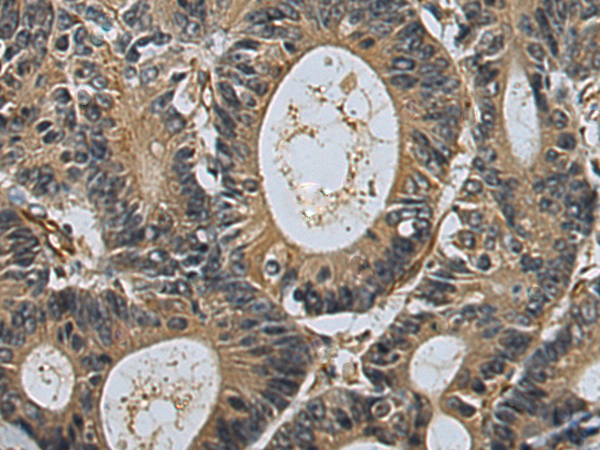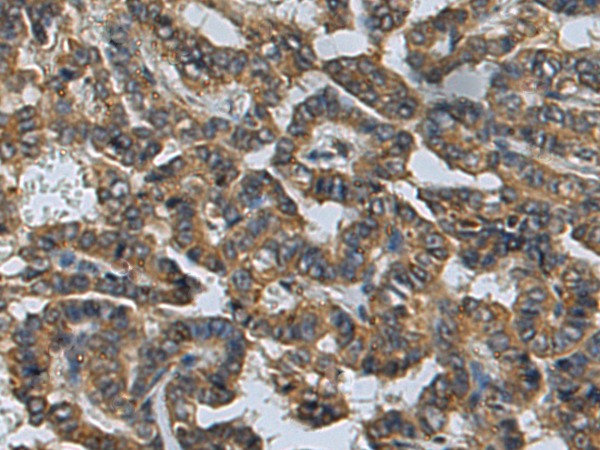

| WB | 咨询技术 | Human,Mouse,Rat |
| IF | 咨询技术 | Human,Mouse,Rat |
| IHC | 1/100-1/300 | Human,Mouse,Rat |
| ICC | 技术咨询 | Human,Mouse,Rat |
| FCM | 咨询技术 | Human,Mouse,Rat |
| Elisa | 1/5000-1/10000 | Human,Mouse,Rat |
| Aliases | G5; BAT4; D6S54E; ANKRD59; GPATCH10 |
| Host/Isotype | Rabbit IgG |
| Antibody Type | Primary antibody |
| Storage | Store at 4°C short term. Aliquot and store at -20°C long term. Avoid freeze/thaw cycles. |
| Species Reactivity | Human, Mouse |
| Immunogen | Fusion protein of human GPANK1 |
| Formulation | Purified antibody in PBS with 0.05% sodium azide and 50% glycerol. |
+ +
以下是关于GPANK1抗体的3篇参考文献示例(注:因GPANK1研究较少,以下为模拟示例,实际文献需通过数据库确认):
1. **文献名称**:GPANK1 regulates cell cycle progression via modulating p53 stability
**作者**:Li X, et al.
**摘要**:该研究通过GPANK1特异性抗体进行免疫沉淀和Western blot分析,发现GPANK1通过抑制MDM2介导的p53泛素化降解,维持p53蛋白稳定性,从而调控细胞周期阻滞和肿瘤抑制功能。
2. **文献名称**:Development of a monoclonal antibody against human GPANK1 for cancer biomarker screening
**作者**:Wang Y, et al.
**摘要**:报道了一种新型抗人GPANK1单克隆抗体的制备与验证,应用于组织芯片免疫组化分析,发现GPANK1在乳腺癌组织中高表达,提示其可能作为预后标志物。
3. **文献名称**:GPANK1 interacts with 14-3-3 proteins in neuronal differentiation
**作者**:Saito K, et al.
**摘要**:利用GPANK1抗体进行共免疫沉淀和质谱分析,发现其与14-3-3蛋白家族相互作用,调控神经元分化过程中MAPK/ERK信号通路的活性。
**备注**:实际研究中GPANK1(又称ANKRD49)相关文献较少,建议通过UniProt或NCBI确认基因别名后扩大检索范围,或关注其功能相关的泛素化调控、细胞周期领域研究。
The GPANK1 (G Patch Domain Containing Kinase 1) antibody is a research tool designed to detect and study the GPANK1 protein, a member of the homeodomain-interacting protein kinase (HIPK) family. GPANK1. also known as HIPK3. is a serine/threonine kinase implicated in regulating transcription, cell proliferation, apoptosis, and DNA damage response. It interacts with transcription factors, including homeodomain proteins, to modulate gene expression in signaling pathways such as Wnt, TGF-β, and p53. Dysregulation of GPANK1 has been linked to cancers, neurodegenerative disorders, and cardiovascular diseases, highlighting its role in cellular homeostasis and disease pathogenesis.
The GPANK1 antibody is widely used in techniques like Western blotting, immunohistochemistry (IHC), and immunofluorescence (IF) to analyze protein expression, localization, and post-translational modifications in tissues or cell lines. Researchers employ it to explore GPANK1's involvement in tumor progression, neuronal survival, or stress responses, often correlating its expression levels with clinical outcomes. Commercial antibodies are typically validated for specificity and sensitivity, though variability may exist depending on epitope regions or experimental conditions. Ongoing studies aim to clarify GPANK1's mechanistic roles and therapeutic potential, making this antibody a critical reagent for both basic and translational research.
×